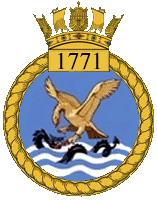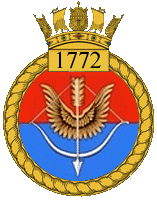
834 Naval Air Squadron was a Naval Air Squadron of the Royal Navy's Fleet Air Arm. The squadron was formed in Jamaica in December 1941 as a torpedo bomber squadron equipped with Fairey Swordfish aircraft. The squadron was embarked on HMS Archer from March 1942 to February 1943 and involved in convoy escorted duties in the Atlantic and Mediterranean. 834 NAS then joined No. 19 Group RAF Coastal Command for duties in the English Channel. In June a flight of Supermarine Seafires was formed and the next month the squadron was embarked on HMS Hunter. The squadron took part in the Salerno landings in September, before being transferred to HMS Battler to provide convoy escort duties in the Indian Ocean. 834 NAS received a further flight of 6 Wildcat Vs in April 1944 and the Seafire flight was disbanded in July. The squadron returned to the UK in November 1944 and was disbanded in December.

722 Naval Air Squadron was a Naval Air Squadron of the Royal Navy's Fleet Air Arm (FAA) created on 7 September 1944, as a Fleet Requirements Unit, where it was responsible for assisting in ship and aircraft gunnery practice. On 24 October 1945 the squadron disbanded following the end of the Second World War.

734 Naval Air Squadron was a Naval Air Squadron of the Royal Navy's Fleet Air Arm (FAA). It was active between February 1944 and February 1946, formed as a naval Engine Handling Unit and operated solely with Armstrong Whitworth Whitley medium bomber aircraft. It formed at and initially operated out of HMS Kestrel, RNAS Worthy Down, and then subsequently relocated to HMS Godwit, RNAS Hinstock and the satellite RNAS Peplow, where it eventually disbanded.

741 Naval Air Squadron was a Naval Air Squadron of the Royal Navy's Fleet Air Arm which last disbanded during November 1947. It was initially active, between March 1943 and March 1945 as an Observer Training Squadron at HMS Condor, RNAS Arbroath, Scotland, as part of the No. 2 Observer Training School. It reformed at HMS Vulture, RNAS St. Merryn, England, as an Operational Flying Training Unit in August 1946.

774 Naval Air Squadron was a Naval Air Squadron of the Royal Navy's Fleet Air Arm which last disbanded in August 1945. 774 Naval Air Squadron formed at HMS Kestrel, RNAS Worthy Down, in November 1939 as an Armament Training Squadron for Observers and TAGs. Aircraft were assigned from storage and a couple of other naval air squadrons. It moved a week later to RAF Aldergrove, and was attached to No.3 Bombing and Gunnery School. In July 1940 it moved to HMS Fieldfare, RNAS Evanton, and then in September to HMS Vulture, RNAS St Merryn, Throughout the next few years, the older aircraft were withdrawn and replaced with newer types and variants. 774 NAS moved to HMS Merganser, RNAS Rattray in October 1944, where it became a target-towing unit.

780 Naval Air Squadron was a Naval Air Squadron of the Royal Navy's Fleet Air Arm which last disbanded at HMS Seahawk, RNAS Culdrose in November 1949. 780 Naval Air Squadron formed at HMS Raven, RNAS Eastleigh as a Conversion Course Unit, in October 1939, to train experienced civilian pilots in naval flying. It moved to HMS Daedalus, RNAS Lee-on-Solent, in October 1940, and later, its role had changed to converting pilots to Fairey Barracuda aircraft. It spent a year at RNAS Charlton Horethorne, before returning to HMS Daedalus and disbanded, early 1945. In March 1946, the squadron reformed at HMS Godwit, RNAS Hinstock, as the Naval Advanced Flying School, to give flying instructors' courses, and later provided Instrument Flying Training. In December, the squadron moved to HMS Jackdaw, RNAS Crail, then in March 1947 moved to HMS Merlin, RNAS Donibristle, and in May to HMS Seahawk as the first resident unit.

797 Naval Air Squadron was a Naval Air Squadron of the Royal Navy's Fleet Air Arm which last disbanded in October 1945 in Ceylon. Its role was a Fleet Requirements Unit which formed at HMS Ukussa, Royal Naval Air Station Katukurunda, in Ceylon, in July 1942. The squadron moved to RNAS Colombo Racecourse in October 1943. It had a Communications Flight which became 742 Naval Air Squadron in December 1943 and the following summer it had an ‘X’ Flight deployed for target towing for a couple of gunnery schools in Bombay, India and which eventually moved to 722 Naval Air Squadron.

1771 Naval Air Squadron was a Naval Air Squadron of the Royal Navy's Fleet Air Arm which disbanded at HMS Nabbington, RNAS Nowra, near Sydney, in October 1945. Notably, the squadron was the first British & Commonwealth unit to fly over Japan in the Second World War. The squadron formed at HMS Heron, RNAS Yeovilton at the start of February 1944, as a Fighter Squadron and also operated from HMS Ringtail, RNAS Burscough, and HMS Landrail, RNAS Machrihanish, with deck landing training on the escort carriers HMS Trumpeter and HMS Ravager before embarking in the fleet carrier HMS Implacable in September. It was involved in sorties over Norway including reconnaisance of the German battleship Tirpitz and other anti-shipping strikes. The squadron remained in HMS Implacable and joined the British Pacific Fleet participating in attacks on the Caroline islands and the Japanese home islands, and becoming part of the 8th Carrier Air Group.

1772 Naval Air Squadron was a Naval Air Squadron of the Royal Navy's Fleet Air Arm (FAA), which last disbanded, at Portsmouth, in March 1946. The squadron formed at HMS Ringtail, RNAS Burscough as a Fighter Squadron during May 1944. It joined HMS Ruler for passage to Australia leaving January 1945 and disembarking at HMS Nabstock, RNAS Schofields, mid-March. The squadron embarked in HMS Indefatigable in July, joining the British Pacific Fleet for attacks againgst the Japanese home islands. After the end of the Second World War it dropped supplies on PoW camps.

1820 Naval Air Squadron was a Naval Air Squadron of the Royal Navy's Fleet Air Arm. It formed at Naval Air Station Brunswick, Maine, on 1 April 1944 and embarked in HMS Arbiter during July. However its aircraft were judged unsatisfactory for their intended role and the squadron disbanded on 16 December 1944 at HMS Ringtail, RNAS Burscough. The squadron only flew one type of aircraft, the Curtiss Helldiver I.
1831 Naval Air Squadron was a Naval Air Squadron of the Royal Navy's Fleet Air Arm. The squadron was formed in 1943 in Rhode Island as a fighter squadron, before being disbanded, reformed and disbanded again after its return to Britain in 1946. It saw no combat during the Second World War.

1833 Naval Air Squadron was a Naval Air Squadron of the Royal Navy's Fleet Air Arm between 1943 and 1945 and then Royal Naval Volunteer Reserve Air Squadron from 1947 to 1957.

1850 Naval Air Squadron was a Naval Air Squadron of the Royal Navy's Fleet Air Arm. It formed in the United States at RN Air Section Brunswick as a fighter squadron in August 1944, with Vought Corsair aircraft before joining HMS Reaper to cross the Atlantic. On arrival in the UK it expanded its aircraft absorbing part of the disbanded 1849 Naval Air Squadron. After working up at HMS Gadwall, at RNAS Belfast, HMS Gannet, at RNAS Eglinton and HMS Wagtail, at RNAS Ayr, the squadron undertook deck landing training on HMS Venerable during February 1945, before joining her sister ship, HMS Vengeance. The ship sailed for the Far East to join the British Pacific Fleet and the squadron went ashore to HMS Valluru at Tambaram and HMS Garuda, at Coimbatore, in southern India in June for weapon training and dive bombing practice, becoming part of the 13th Carrier Air Group. With the end of the Second World War it returned to the UK and disbanded at HMS Siskin, at RNAS Gosport, in August 1946.
1843 Naval Air Squadron was a Naval Air Squadron of the Royal Navy's Fleet Air Arm between 1943 and 1945 and then a Royal Naval Volunteer Reserve Air Squadron from 1953 to 1957. It formed in the United States at RN Air Section Brunswick, in May 1944, as a fighter squadron. It arrived in the UK aboard HMS Trouncer in August. Based at HMS Gannet, RNAS Eglinton, Northern Ireland and training at HMS Wagtail, RNAS Ayr, Scotland, the squadron had deck landing training aboard HMS Patroller in December, before joining HMS Arbiter in February 1945, as part of the 10th Naval Fighter Wing. Sailing to Australia, the squadron became part of the 3rd Carrier Air Group, but saw no action before the war ended and disbanded in October 1945. It reformed as a Royal Naval Volunteer Reserve Air Branch anti-submarine squadron, in the Scottish Air Division, from 1953 and disbanded in 1957.

1844 Naval Air Squadron was a Naval Air Squadron of the Royal Navy's Fleet Air Arm between 1943 and 1945 and then a Royal Naval Volunteer Reserve Air Squadron from 1954 to 1957. It formed in Northern Ireland at HMS Gannet, RNAS Eglinton, in December 1943, as a fighter squadron. It embarked in HMS Begum, in February 1944, for the Far East, arriving in Ceylon, in June and joining HMS Indomitable the following month. August, September and October saw the squadron undertake photographic reconnaissance and provide fighter cover for the attacks on Indaroeng and Emmahaven in Sumatra, then on Sigli, followed by the Nicobar Islands respectively.

1845 Naval Air Squadron was a Naval Air Squadron of the Royal Navy's Fleet Air Arm. It formed at RN Air Section Brunswick, United States, in June 1944 as a fighter squadron, with eighteen Vought Corsair Mk III fighter aircraft. It embarked in HMS Puncher on 30 August, disembarking to HMS Gannet, RNAS Eglinton, Northern Ireland, on 18 September and joining the 10th Naval Fighter Wing. It re-equipped with twenty-four Vought Corsair Mk IV, and embarked HMS Slinger in December, sailing for the British Pacific Fleet, the squadron was disbanded in April 1945, and its aircraft and personnel absorbed into squadrons aboard the aircraft carriers HMS Formidable and HMS Victorious. On 1 June it reformed in Australia as a single seater fighter squadron at HMS Nabsford, RNAMY Archerfield, Queensland, and it shortly later became a spare squadron in the 3rd Carrier Air Group at HMS Nabbington, RNAS Nowra, New South Wales. With the end of the Second World War the squadron disbanded on 24 October.

1847 Naval Air Squadron was a Naval Air Squadron of the Royal Navy's Fleet Air Arm. It formed, at the start of February 1944, at, RNAS Eglinton, Derry, Northern Ireland, as a fighter squadron with eight of its twelve pilots from the Royal Netherlands Navy, and was equipped with Grumman Hellcat fighter aircraft. After three months existence the squadron was absorbed into 1840 Naval Air Squadron, at HMS Gannet, during May 1944.

1848 Naval Air Squadron was a Naval Air Squadron of the Royal Navy's Fleet Air Arm. It officially formed in the United States at RN Air Section Brunswick, in July 1944 as a fighter squadron. It was quipped with Vought Corsair fighter aircraft. The squadron embarked in HMS Ranee in October for the Atlantic crossing back to the United Kingdom. However, soon after arrival it disbanded at HMS Landrail, at RNAS Machrihanish, in November, its resources shared equally between 1843, 1845 and 1846 Naval Air Squadrons.

1849 Naval Air Squadron was a Naval Air Squadron of the Royal Navy's Fleet Air Arm. It formed in the United States at RN Air Section Brunswick as a fighter squadron at the start of 1944, equipped with Vought Corsair fighter aircraft. It embarked in HMS Reaper for transport to the UK in November. The squadron suffered from a high accident rate and disbanded on arrival in the UK, in December, with its aircraft and personnel dispersed between 1845 and 1850 Naval Air Squadrons.
















